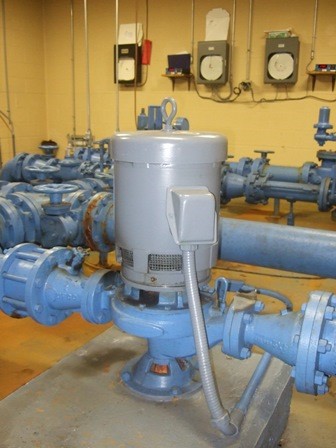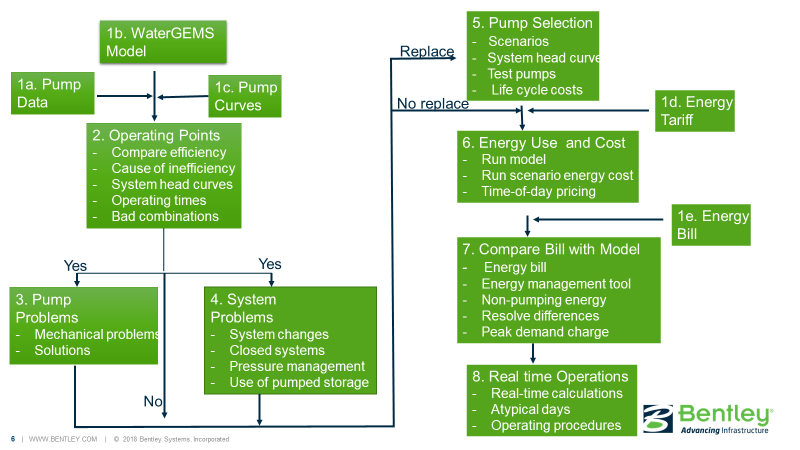Virtuosity Blog
Doin' the Pump Energy Blues
Pumping energy is usually one of the largest components of operating costs for most water systems. And it’s not a trivial cost for wastewater utilities either. Utilities want to reduce these costs, and I doubt that any system doesn’t have some room for improvement.
When I walk into a pump station, it’s like walking into a gold mine. There are little nuggets of energy gold lying all over the place. But like in mining, you need to dig a little to find these energy gems. A pump that is wasting your money is not going to call out to you, “Hey, look at me, I’m wasting your money.” A pump that is wasting money looks, sounds, feels and, probably smells and tastes like a good pump. It’s up to you to find the pump with the excessive energy appetite and either fix it or replace it.


Can you tell which pump is wasting energy? Not if you don’t do some analysis.
Your hydraulic model can be a valuable tool to help you identify the bad actors and save money. Part of the problem is that there are many reasons your pumping operations can lose money for you. And accordingly, there are many ways to correct the problems. It would be nice if there was one big button in OpenFlows WaterGEMS that said, “Save my energy," and one push of that button would solve all of your problems.
There can be system problems or pump mechanical problems. You may need to replace pumps or modify the operation of existing pumps. You may not be taking advantage of the power company's rate tariff, and you find you are using energy at the wrong time of day. You may have pumps that run efficiently by themselves but don’t play well together when you try to run both at once. You may find that your operators are running pumps efficiently in terms of energy but are blowing the energy budget on demand charges. If you have the opportunity to buy new pumps, you need to make sure you are picking the right pumps for the future, or you’ll be paying for the mistake for 20 years or more.
There are a lot of things you can do to find and correct energy problems. I see them applied in a somewhat random order and yield limited benefits. Over the years, I evolved what I consider a good workflow for saving energy. I’ve summarized in it the flowchart below. It leads you from the data you need to identify problems, down to fixing the problems you find and transferring the best practices to the folks who actually operate the pumps. The steps generally involve data collection, modeling with OpenFlows WaterGEMS/OpenFlows WaterCAD, and working like a diligent gold miner.

There is no law that says you must complete every step in the order shown in the flow chart. You may not have sufficient data to do some things, or you may not have a peak demand charge at all of your stations. But this flow chart should be a useful road map even if you take some side trips.
There is usually a nice payback when you do find energy waste, and it comes quickly. But you need to do the analysis. Too often, someone starts on this type of assessment, and I’ll call them a few months later, and they say, “I started, but I got pulled off on x, and then y, and then there was z. I plan to get back on pump energy in February.” You’ll only get savings if you complete the assessment and implement the improvements.
If you want to take a deeper dive into this topic, I will be doing a Bentley “Coffee Corner” presentation on pumps and energy on 09 December 2021 (They call it a “coffee corner” because you may need coffee to keep awake.) I’ll be explaining those steps inside those green boxes above. Anyway, if you are receiving this blog, you should get an invitation to that online session.
If you want an even more in-depth version, I’ll be doing a two-hour version at the Pennsylvania AWWA Conference in State College, PA, on 26 Apr 2022. That in-person class has been approved by PA DEP for operator training. (Check with your state if they will accept PA certified training as continuing education for operators.) If all goes well, that should be the first conference I’ll attend since the start of the pandemic.
Whether or not you take some additional training or follow my flow chart, keep looking for those energy savings.
If you want to look up past blogs, go to https://blog.virtuosity.com/tag/water-and-wastewater. And if you want to contact me (Tom), you can email tom.walski@bentley.com.
Want to learn more from our resident water and wastewater expert? Join the Dr. Tom Walski Newsletter today!

